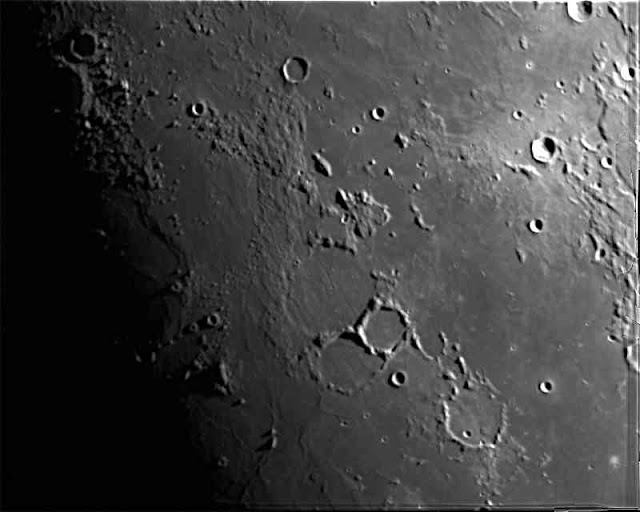Que
the Apollo 13 music...
If
you are as old as I am, you were around during the Apollo Moon
Missions, which would be basically 1969 to about 1974 or so. I think.
I can't remember exactly when the U.S gave up on going to the moon. A
big mistake in my opinion. But that's not what this entry is about.
The mission that was called the “successful failure” is, of
course, Apollo 13. Intense to follow real time and a pretty good
movie, staring Tom Hanks. That would be the music I'm referring to in
my title. I think the original sound track is pretty good, too. I'm
still off point, sorry. The point is that the landing area for Apollo
was the crater Fra Mauro. It was not until Wednesday night, the
13th, that I was able to image it, or anything for quite
some time. The past several months have been the cloudiest I can seen
for a long time.
I
didn't know Fra Mauro's location on the moon until a few days before
the 13th. Earlier the spring, while it was cloudy, I
decided I wanted images of the Astronomical League's Lunar List,
which can be found on their web site. (You don't need a telescope for
all the items, so you could download the list and see how many you
could see.) I looked over the images of the moon I already have and
found I already have about 60% of the list. One that I didn't, up
until now, was Fra Mauro. And, to me, that's a rather important one.
So, I basically got lucky on the evening of the 13th
because Fra Mauro was near the terminator, which is an ideal
placement for imaging and it was CLEAR. Well, clear enough. So,
without further ado (or finally...what's taking so long as some would
say).....
 |
| So, which crater IS Fra Mauro? Well, it's this one. With the white dot that is |
 |
| Now that you know which one it is, this is the same image without the identification. |
 |
| Thanks to Virtual Moon Atlas, this is where Fra Mauro is in relation to the whole moon. |
My image is the best 95% of 1100 images taken on the 13th. Remember
that I do lunar and planetary imaging with a webcam, so that
represents only 34 seconds of time to take the 1100 images. In fact,
I was able to open the observatory, turn everything on, get
everything aligned, take the images, visually observe Alberio
(probably my favorite double star) and epsilon Lyre (the famous
“double double”. Naked eye, it appears as one star; in binoculars
or telescope at low power, it appears as a double star; on high
power, the each star of the double star resolves into a double star;
hence the double double. If a planet could fit somewhere in there, it
could have 4 suns. Probably wouldn't get much sleep....). Then turn
everything off, put everything up, and close the observatory, all
within an hour. That's pretty fast for me.
Well,
that's about it for this time. Should the skies part again for an
hour or so, I hope to get another Mars and Saturn.... I've got an
idea for something a little different I want to try next time.
PS, Just as an aside, my image happens to show one of the many challenges of imaging, dynamic range. Dynamic range here refers to the difference, in the image, between the lightest and darkest areas. The crater in the upper right of the image is completely white while the left side of the image is completely black. Computers assign a value of of 0 (zero) to black and 255 to white on most displays (which are 8 bit). When the limits of 0 or 255 are reached, in the image, information is lost. There is no way to discover if there is more information, or image, in either the black or white regions. The "trick" in most imaging is to not reach either limit, 0 or 255, in an image. Sometimes, it just isn't your day... :)
PS, Just as an aside, my image happens to show one of the many challenges of imaging, dynamic range. Dynamic range here refers to the difference, in the image, between the lightest and darkest areas. The crater in the upper right of the image is completely white while the left side of the image is completely black. Computers assign a value of of 0 (zero) to black and 255 to white on most displays (which are 8 bit). When the limits of 0 or 255 are reached, in the image, information is lost. There is no way to discover if there is more information, or image, in either the black or white regions. The "trick" in most imaging is to not reach either limit, 0 or 255, in an image. Sometimes, it just isn't your day... :)
No comments:
Post a Comment